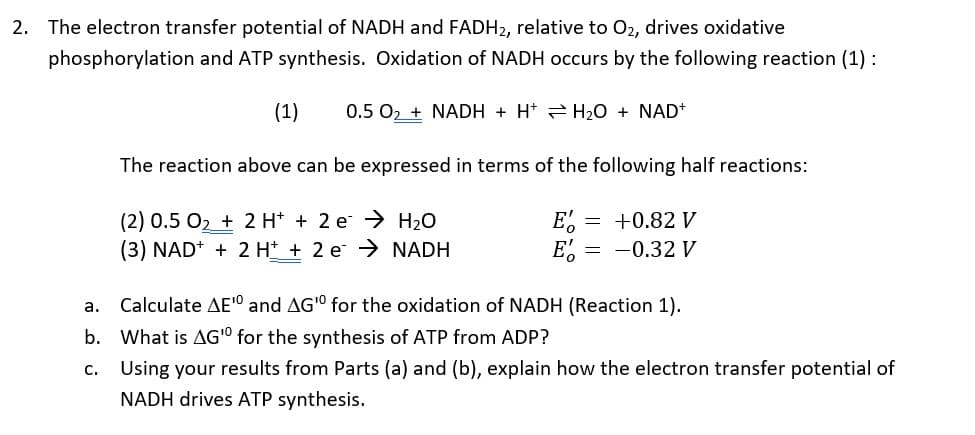2. The electron transfer potential of NADH and FADH2, relative to O2, drives oxidative phosphorylation and ATP synthesis. Oxidation of NADH occurs by the following reaction (1) : (1) 0.5 02 + NADH + H* H20 + NAD* The reaction above can be expressed in terms of the following half reactions: (2) 0.5 O2 + 2 H* + 2 e > H20 (3) NAD* + 2 H* + 2 e → NADH E. E, = -0.32 V = +0.82 V а. Calculate AE'0 and AGO for the oxidation of NADH (Reaction 1). b. What is AG'" for the synthesis of ATP from ADP? С. Using your results from Parts (a) and (b), explain how the electron transfer potential of NADH drives ATP synthesis.
2. The electron transfer potential of NADH and FADH2, relative to O2, drives oxidative phosphorylation and ATP synthesis. Oxidation of NADH occurs by the following reaction (1) : (1) 0.5 02 + NADH + H* H20 + NAD* The reaction above can be expressed in terms of the following half reactions: (2) 0.5 O2 + 2 H* + 2 e > H20 (3) NAD* + 2 H* + 2 e → NADH E. E, = -0.32 V = +0.82 V а. Calculate AE'0 and AGO for the oxidation of NADH (Reaction 1). b. What is AG'" for the synthesis of ATP from ADP? С. Using your results from Parts (a) and (b), explain how the electron transfer potential of NADH drives ATP synthesis.
Chemistry & Chemical Reactivity
10th Edition
ISBN:9781337399074
Author:John C. Kotz, Paul M. Treichel, John Townsend, David Treichel
Publisher:John C. Kotz, Paul M. Treichel, John Townsend, David Treichel
Chapter24: Biochemistry
Section: Chapter Questions
Problem 34GQ: The first step of the metabolic process known as glycolysis is the conversion of glucose to glucose-...
Related questions
Question

Transcribed Image Text:2. The electron transfer potential of NADH and FADH2, relative to O2, drives oxidative
phosphorylation and ATP synthesis. Oxidation of NADH occurs by the following reaction (1) :
(1)
0.5 02 + NADH + H* H20 + NAD*
The reaction above can be expressed in terms of the following half reactions:
(2) 0.5 O2 + 2 H* + 2 e > H20
(3) NAD+ + 2 H* + 2 e → NADH
E.
E,
= -0.32 V
= +0.82 V
Calculate AE'" and AGO for the oxidation of NADH (Reaction 1).
а.
b. What is AG'º for the synthesis of ATP from ADP?
c. Using your results from Parts (a) and (b), explain how the electron transfer potential of
NADH drives ATP synthesis.
Expert Solution
This question has been solved!
Explore an expertly crafted, step-by-step solution for a thorough understanding of key concepts.
This is a popular solution!
Trending now
This is a popular solution!
Step by step
Solved in 2 steps with 2 images

Knowledge Booster
Learn more about
Need a deep-dive on the concept behind this application? Look no further. Learn more about this topic, chemistry and related others by exploring similar questions and additional content below.Recommended textbooks for you

Chemistry & Chemical Reactivity
Chemistry
ISBN:
9781337399074
Author:
John C. Kotz, Paul M. Treichel, John Townsend, David Treichel
Publisher:
Cengage Learning

Chemistry & Chemical Reactivity
Chemistry
ISBN:
9781133949640
Author:
John C. Kotz, Paul M. Treichel, John Townsend, David Treichel
Publisher:
Cengage Learning

Introduction to General, Organic and Biochemistry
Chemistry
ISBN:
9781285869759
Author:
Frederick A. Bettelheim, William H. Brown, Mary K. Campbell, Shawn O. Farrell, Omar Torres
Publisher:
Cengage Learning

Chemistry & Chemical Reactivity
Chemistry
ISBN:
9781337399074
Author:
John C. Kotz, Paul M. Treichel, John Townsend, David Treichel
Publisher:
Cengage Learning

Chemistry & Chemical Reactivity
Chemistry
ISBN:
9781133949640
Author:
John C. Kotz, Paul M. Treichel, John Townsend, David Treichel
Publisher:
Cengage Learning

Introduction to General, Organic and Biochemistry
Chemistry
ISBN:
9781285869759
Author:
Frederick A. Bettelheim, William H. Brown, Mary K. Campbell, Shawn O. Farrell, Omar Torres
Publisher:
Cengage Learning